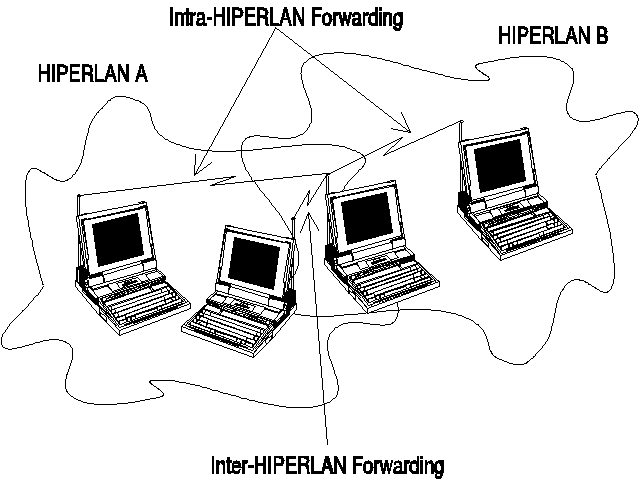
 |
JPL's Wireless Communication Reference WebsiteChapter: Network Concepts and Standards
|
When the signal path is not limited to be in a shielded coaxial- or UTP (unshielded twisted pair) cable, it puts a totally new set of security aspects on the usage of wireless LANs. The essential difference between a HIPERLAN and any existing standard sub-network is the intrinsic sharing of the communications medium and the mobility in the networking environment. In HIPERLAN each communicating node is given a set of identifiers: A Hiperlan ID (HID) and a Node ID (NID). The combination of these two IDs uniquely identifies any station, and restricts the way it can connect to other HIPERLAN nodes. Within one single HIPERLAN (that is, among nodes that have the same HID), all nodes can communicate with each other. The nodes are using a dynamic routing mechanism denoted Intra-HIPERLAN Forwarding. If a node comes within range of another HIPERLAN, it may try to establish communications to its own HIPERLAN via the new HIPERLAN, if the two HIPERLANs allow it. To establish such a connection a routing scheme denoted Inter-HIPERLAN Forwarding is used. Inter-HIPERLAN Forwarding requires a bilateral agreement between the two HIPERLANs.
It is essential to note, that HIPERLAN in itself does not support any features directly related to end-to-end security. Encryption services are planned for in HIPERLAN (the IEEE 802.11 standard has provision for MAC-layer encryption, denoted Wired Equivalent Privacy, to indicate, that the security to expect from the MAC-layer is at a comparable level to that of a wired infrastructure.), but the Intra- and Inter-HIPERLAN Forwarding are only sub-MAC layer functions that together with the HIPERLAN Management functions resolves the complex task of routing and bridging. As with other OSI standards, secure data transport is obtained in layers above the MAC layer, and is in the case of HIPERLAN the responsibility of the HIPERLAN service requester.

Figure 3 Inter- and Intra HIPERLAN Forwarding in two different HIPERLANs